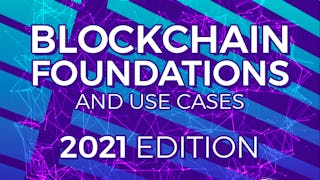Blockchain promises to disrupt industries once it will be efficient at large scale. In this course, you will learn how to make blockchain scale. You will learn about the foundational problem of distributed computing, consensus, that is key to create blocks securely. By illustrating limitations of mainstream blockchains, this course will indicate how to improve the technology in terms of security and efficiency.

Gain next-level skills with Coursera Plus for $199 (regularly $399). Save now.

Blockchain Scalability and its Foundations in Distributed Systems

Instructor: Vincent Gramoli
13,576 already enrolled
Included with
(119 reviews)
Recommended experience
Skills you'll gain
Details to know

Add to your LinkedIn profile
6 assignments
See how employees at top companies are mastering in-demand skills

There are 5 modules in this course
This week, we will start our exploration of the blockchain and its relation to distributed computing. In particular, we will learn the basics on blockchain abstraction and the importance of consensus between machines in order to mitigate the risks of having an attacker spend the same asset twice - an undesirable situation called 'double-spending'.
What's included
7 videos4 readings1 assignment1 discussion prompt
This week we will learn how classic blockchains try to solve consensus. We will look at the failures and delays blockchain systems must consider, and how these events may prevent machines from reaching consensus.
What's included
10 videos2 readings1 assignment1 discussion prompt
This week, we will investigate how to solve the consensus problem. To do this, we will first investigate how to solve consensus when failures cannot occur in the network. Later on, we will learn how to solve consensus when processes may fail, first through crash failures and then when processes can behave arbitrarily.
What's included
7 videos1 reading1 assignment1 discussion prompt
This week, we will investigate how delays in the network can impact the security of the blockchain. We will illustrate this using network attacks that allow hackers to steal digital assets in the past and that every blockchain designer should be aware of.
What's included
6 videos4 readings1 assignment1 discussion prompt
This week, we will explore how to design a scalable and secure blockchain algorithm. What makes a blockchain algorithm scalable and secure? To be secure, we need a consensus algorithm that works over the Internet and is not affected by unexpected communication delays. To be scalable, we need to get rid of the bottlenecks.
What's included
9 videos5 readings2 assignments2 discussion prompts
Instructor

Offered by
Explore more from Computer Security and Networks
 Status: Free Trial
Status: Free TrialUniversity of California, Irvine
 Status: Preview
Status: PreviewUniversity of Illinois Urbana-Champaign
 Status: Free Trial
Status: Free TrialUniversity of California, Irvine
 Status: Preview
Status: PreviewConsenSys Academy
Why people choose Coursera for their career




Learner reviews
119 reviews
- 5 stars
70.83%
- 4 stars
19.16%
- 3 stars
5%
- 2 stars
1.66%
- 1 star
3.33%
Showing 3 of 119
Reviewed on Dec 14, 2021
This course very help full for me because currently doing research project in collage and work on blockchain scalability problem and its solutions
Reviewed on Jun 18, 2023
Some practical aspects through simulation/ emiulation could have been included to provide more benefits to learners.
Reviewed on Jun 20, 2022
While it is a great learning experience, I would recomend adding some further details / explaination on algorithms, specially EIG, DBFT, BCA and BVBA in video format.

Open new doors with Coursera Plus
Unlimited access to 10,000+ world-class courses, hands-on projects, and job-ready certificate programs - all included in your subscription
Advance your career with an online degree
Earn a degree from world-class universities - 100% online
Join over 3,400 global companies that choose Coursera for Business
Upskill your employees to excel in the digital economy
Frequently asked questions
To access the course materials, assignments and to earn a Certificate, you will need to purchase the Certificate experience when you enroll in a course. You can try a Free Trial instead, or apply for Financial Aid. The course may offer 'Full Course, No Certificate' instead. This option lets you see all course materials, submit required assessments, and get a final grade. This also means that you will not be able to purchase a Certificate experience.
When you purchase a Certificate you get access to all course materials, including graded assignments. Upon completing the course, your electronic Certificate will be added to your Accomplishments page - from there, you can print your Certificate or add it to your LinkedIn profile.
Yes. In select learning programs, you can apply for financial aid or a scholarship if you can’t afford the enrollment fee. If fin aid or scholarship is available for your learning program selection, you’ll find a link to apply on the description page.
More questions
Financial aid available,

